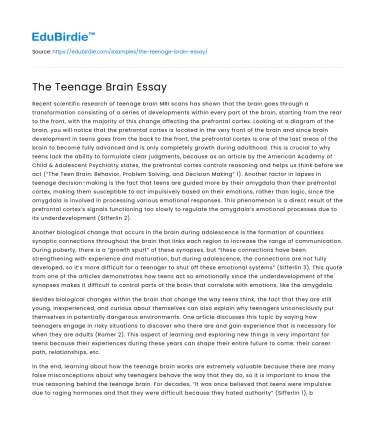Recent scientific research of teenage brain MRI scans has shown that the brain goes through a transformation consisting of a series of developments within every part of the brain, starting from the rear to the front, with the majority of this change affecting the prefrontal cortex. Looking at a diagram of the brain, you will notice that the prefrontal cortex is located in the very front of the brain and since brain development in teens goes from the back to the front, the prefrontal cortex is one of the last areas of the brain to become fully advanced and is only completely growth during adulthood. This is crucial to why teens lack the ability to formulate clear judgments, because as an article by the American Academy of Child & Adolescent Psychiatry states, the prefrontal cortex controls reasoning and helps us think before we act (“The Teen Brain: Behavior, Problem Solving, and Decision Making” 1). Another factor in lapses in teenage decision-making is the fact that teens are guided more by their amygdala than their prefrontal cortex, making them susceptible to act impulsively based on their emotions, rather than logic, since the amygdala is involved in processing various emotional responses. This phenomenon is a direct result of the prefrontal cortex’s signals functioning too slowly to regulate the amygdala’s emotional processes due to its underdevelopment (Sifferlin 2).
Another biological change that occurs in the brain during adolescence is the formation of countless synaptic connections throughout the brain that links each region to increase the range of communication. During puberty, there is a “growth spurt” of these synapses, but “these connections have been strengthening with experience and maturation, but during adolescence, the connections are not fully developed, so it’s more difficult for a teenager to shut off these emotional systems” (Sifferlin 3). This quote from one of the articles demonstrates how teens act so emotionally since the underdevelopment of the synapses makes it difficult to control parts of the brain that correlate with emotions, like the amygdala.
Save your time!
We can take care of your essay
- Proper editing and formatting
- Free revision, title page, and bibliography
- Flexible prices and money-back guarantee
Besides biological changes within the brain that change the way teens think, the fact that they are still young, inexperienced, and curious about themselves can also explain why teenagers unconsciously put themselves in potentially dangerous environments. One article discusses this topic by saying how teenagers engage in risky situations to discover who there are and gain experience that is necessary for when they are adults (Romer 2). This aspect of learning and exploring new things is very important for teens because their experiences during these years can shape their entire future to come: their career path, relationships, etc.
In the end, learning about how the teenage brain works are extremely valuable because there are many false misconceptions about why teenagers behave the way that they do, so it is important to know the true reasoning behind the teenage brain. For decades, “It was once believed that teens were impulsive due to raging hormones and that they were difficult because they hated authority” (Sifferlin 1), but these are all stereotypes that adults commonly involved in teenagers’ lives--doctors, teachers, parents-- created long before technology could debunk these old platitudes with scientific evidence. Learning about the real reason why teens behave the way they do is important also because it explains that regardless of how many differences there are between teenage and adult brains and decision-making, this transformation that teens go through during their adolescence is something completely normal that everyone goes through or has gone through in their life. This is can be seen by how when I interviewed my mom and asked her questions about her teenage life, her experiences were very similar to what I am going through right now.






 Stuck on your essay?
Stuck on your essay?

